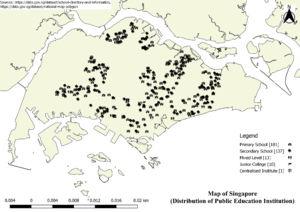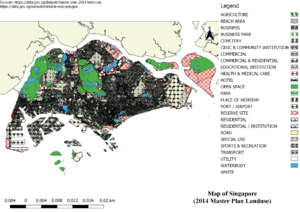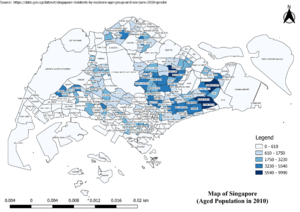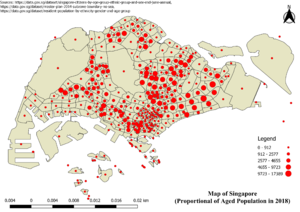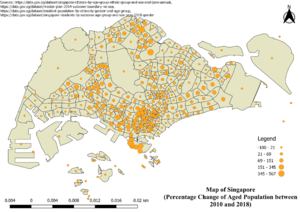SMT201 AY2019-20T1 EX1 Eddie Leow Kian Giap
Part 1: Thematic Mapping
- Using school information from data.gov.sg, prepare a thematic map showing the distribution of public education institution by school types such as primary, secondary, etc.
I have categorized the data set according to the school type such as Primary, Secondary, Mixed Level, Junior College and Centralised Institution. My cartographic technique is to use an icon which represents the school type. For example, I used an icon that states "ABC" to indicate a primary school. The icon is given a width and height of 4 so that it can display clearly on the map without overlapping other nearby school types.
- Using road GIS data of LTA, prepare a thematic map showing the hierarchy of road network system of Singapore such as expressway, major road, minor road, etc.
For this data set, I have categorized them according to the road network system such as expressway, expressway slip road, main road and minor road. My cartographic technique is to use different line colours to represent each system or hierarchy. This gives a clear view of expressway, expressway slip road, major road and minor road to users.
- Using master plan landuse GIS data from data.gov.sg, prepare a thematic map showing 2014 Master Plan Landuse.
As there are many different usage of land, I have grouped some of them together then categorized them with icons or colours to represent the type. One of the groupings I have done is all the business-related type is grouped into business. The icons selected for each type represents the purpose of it. For example, open space is defined by green colour and park is defined by a tree icon.
Part 2: Choropleth Mapping
Using planning subzone GIS data from data.gov.sg and Singapore residents by age group and gender, prepare the following choropleth maps:
- Aged population (+65) in 2010.
- Aged population (+65) in 2018.
The spatial pattern for both choropleth maps for Aged population in 2010 and 2018 is Area Pattern. Aged population refers to Singapore Residents who are 65 years old and above. From the pattern, it is observed that there are changes to the subzone name over the years. For example, Tuas Coast has changed to Tuas View Extension. Seletar subzone has been further divided into Pulau Punggol Barat subzone and Seletar subzone.
- Proportional of aged population in 2010.
- Proportional of aged population in 2018.
Point pattern is the spatial pattern for Proportional of aged population in 2010 and 2018. Uniform and clustered types are observed from the map. As the base map is 2014 Master Plan Subzone from data.gov, there are points in 2010 which are off the outline due to the changes over the years.
- Percentage change of aged population between 2010 and 2018.
For the percentage change of aged population between 2010 and 2018, the spatial pattern is point pattern. Similarly to the proportional of aged population in 2010 and 2018, the two types of point pattern observed from the map are uniform type and clustered type. In this map, clustered points are more prominent compared to the proportional of aged population in 2010 and 2018 because of the change of name for few subzones. It can be observed that there are some subzones which have a steep increase of aged population living in the subzone, vice versa.
All choropleth mappings are classified with graduated symbology. As the data sets are right-skewed distribution, natural breaks mode is used to bin the values into 5 classes.
There are few new variables created as stated below.
- Aged65+
Derived from the sum of resident counts who are 65 years old and above in 2010.
- 2017_Aged6
Derived from the sum of resident counts who are 65 years old and above in 2017.
- Percentage
Derived from 2017_Aged6 divided by 516692. 516692 is the total resident counts who are 65 years old and above in 2017.
Referenced from https://data.gov.sg/dataset/resident-population-by-ethnicity-gender-and-age-group
- 2018_Predi
Derived from Percentage multiply by 547854. 547854 is the total resident counts who are 65 years old and above in 2018.
An assumption is made that the size of subzone does not change.
Referenced from https://data.gov.sg/dataset/resident-population-by-ethnicity-gender-and-age-group
- Pct_Change
Derived from [((2018_Predi - Aged65+) / Aged65+) * 100]
An assumption made on all the data sets is if it does not affect the outcome of the result, it will be ignored. For example, the data set for 2017/2018 has missing values for timestamp, begin, end, etc and these values do not contribute to the classification. Hence it is ignored.
There are missing values when 2010 and 2018 data sets are joined together. There are few reasons which could explain for the missing values. It is due to the further division of subzone or the name of subzone has changed. The actual value is hard to determine by the data set unless collecting the missing values which is impossible for this assignment. In this case, an assumption is made that all the subzones with missing value is replace with 0.
